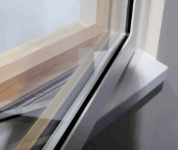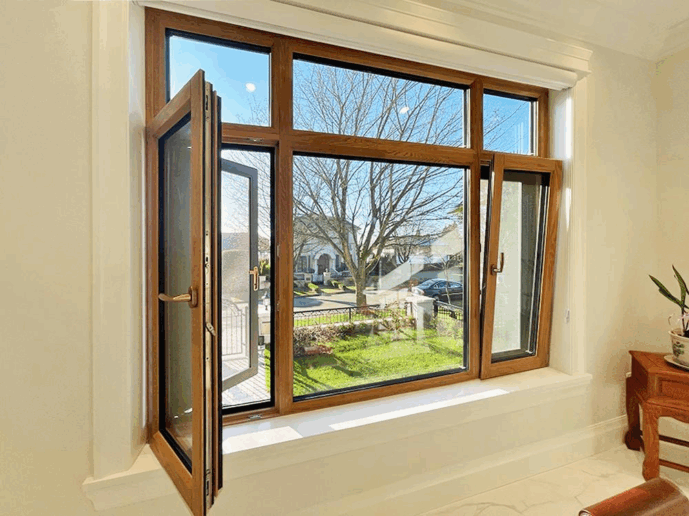
Hybrid Windows vs Replacement Cost Over 20 Years
Is it cheaper to buy better windows once or to replace cheaper ones twice?
Let’s look at it from the 20-year picture.
The picture might vary a lot in that case.
Quick example to set the stage:
- A hybrid window might cost more on day one.
- A budget vinyl window might cost less now but need a full swap in year 10 to 12.
- Our math shows which path wins over 20 years for a typical home.
Understanding The Metarial
What are hybrid windows?
Hybrid windows combine two materials to balance strength, weather protection, and looks.
- Aluminum-clad wood: wood inside, aluminum shell outside.
- Fiberglass exterior with wood interior.
- uPVC or composite frame with an aluminum capstock.
Why hybrids exist:
- Tough exterior for sun, rain, and cold.
- Warm look and feel inside.
- Stable frames that resist warping.
- Good thermal performance with modern glazing.
What is the “replacement path”?
This path starts with builder-grade or mid-grade vinyl.
You pay less now.
You plan to replace the same windows once within 20 years.
- Many owners target a full replacement around year 10 to 12.
- Some stretch to year 15, but failure risk rises.
What this comparison does not cover:
- Historic wood restoration.
- Commercial curtain wall systems.
- Specialty shapes that need custom engineering.
Simple example:
- Option A: Hybrid windows now and follow a light maintenance plan.
- Option B: Mid-grade vinyl now, then replace everything once in the next 20 years.
The Cost Framework

We will use a total cost of ownership model over 20 years.
Formula
TCO = Purchase + Install + Maintenance + Repairs − Warranty coverage + Energy cost + Owner time cost − Resale uplift
What each line means
- Purchase and install: the invoice on day one, including trim and disposal.
- Maintenance: paint or stain cycles, caulking, hardware service, cleaning supplies.
- Repairs: glass seal failures, hardware breaks, sash or IGU swaps.
- Warranty coverage: what the maker pays for when parts fail.
- Energy cost: heating and cooling over 20 years based on U-factor, SHGC, and air leakage.
- Owner time cost: the value of your hours spent on upkeep or scheduling contractors.
- Resale uplift: any price premium a buyer pays for higher grade windows
Key assumptions to set before you run numbers
- Number of windows and average size.
- Climate zone and exposure.
- Local labour rates for painters and installers.
- Energy price today and a simple growth rate.
- Inflation rate and discount rate for present value.
Sample inputs to make it real
- Home with 20 windows in a mixed climate.
- Hybrid unit installed: 1,100 to 1,400 per window.
- Mid-grade vinyl installed: 600 to 850 per window.
- Full vinyl replacement in year 12: today’s price plus modest inflation.
- Paint or finish refresh for hybrids in year 8 to 10 if wood is exposed.
- Energy savings: hybrids with better glass save 5 to 10 percent vs a basic vinyl spec.
- Discount rate: 4 to 6 percent.
With these inputs you can build a clean 20-year cashflow.
Next, we will plug numbers into simple tables and see when each option breaks even.
The Cost Of Components
CapEx
This is the price to buy and install the windows. It includes disposal, trims, sill pans, and flashing.
Example: a hybrid at 1,250 installed vs a vinyl at 750 installed per window.
Maintenance
This covers finish touch-ups, caulking, hardware lube, and cleaning supplies. Hybrids with wood inside may need a light finish refresh after several years.
Example: perimeter caulk at year 5 for 20 windows can take one day of labour and a few tubes of sealant.
Failures and Repairs
This is for glass seal failures, warped frames, water intrusion fixes, and broken hardware. The rate depends on quality and install.
Example: a failed insulated glass unit may cost 250 to 450 to replace, labour included.
Energy
This is the cost to heat and cool the home. It depends on U-factor, SHGC, and air leakage. A better glass package lowers the bill.
Example: switching from basic double pane to low-E argon can save 5 to 10 percent in a mixed climate.
Warranty Reality
Look at term length and what is covered for frame, glass, finish, and labour. Read exclusions.
Example: a glass seal warranty might be 20 years on parts but only 2 years on labour.
Owner Time Cost
Your time has value. Count the hours to schedule service, meet crews, or do DIY work.
Example: two mornings off work at 3 hours each can add real cost.
Resale Uplift
Buyers often value higher grade windows. It may not repay every dollar, but it can support a better offer or faster sale.
Example: an appraiser may note new premium windows in the report for comps.
Comfort and Other Benefits
Less draft, less noise, better surface temperatures, and less condensation are real wins.
These do not show up as cash, yet they matter in daily life.
Scenarios to Model
A. Premium Hybrid Once
You buy hybrids now. You follow a light maintenance plan. No full replacement in 20 years.
Example input: 20 windows at 1,250 installed each.
B. Mid-Grade Vinyl plus One Replacement
You buy vinyl now. You replace all windows once within the 20-year period. Year 12 is a common target.
Example input: 20 windows at 750 installed now, then the same scope at future price with inflation.
C. Budget Vinyl Twice
You choose entry vinyl and plan to replace sooner. This is a low upfront, high churn path.
Example input: 20 windows at 600 installed now, then replace around year 10.
D. All-Fiberglass Control
Use this as a reference if you are also looking at full fiberglass. It helps anchor the upper end.
Example input: 20 windows at 1,300 to 1,500 installed each.
Keep assumptions consistent across scenarios. Same house. Same climate. Same glass tier where possible. Only change what defines the scenario.
20-Year Cashflow
Your table tracks every cost by year. Start at year 0 with purchase and install. Add planned maintenance in the years it occurs. Add expected repairs with a simple rate. Add energy cost every year. Subtract covered warranty amounts. Include owner time where it happens. Sum the running total so you can see the curve for each scenario.
Here is a simple way to set it up:
- Rows are years 0 to 20.
- Columns are CapEx, Maintenance, Repairs, Warranty offsets, Energy, Owner time, and Cumulative total.
- One tab per scenario. One chart that plots all cumulative totals on the same axis.
Example snapshot for Scenario B:
- Year 0: CapEx 15,000 for 20 vinyl windows. Energy baseline starts.
- Year 5: Maintenance 500 for caulk and tune-ups.
- Year 12: Replacement CapEx 18,000 after inflation. Old window disposal included.
- Each year: Energy cost line and minor repair allowance, such as 150.
When you graph the cumulative totals, you see where the lines cross. The cross point is your break-even year. If the hybrid line stays below the vinyl replace-once line by year 12 to 15, the premium choice wins on cost and on comfort.




